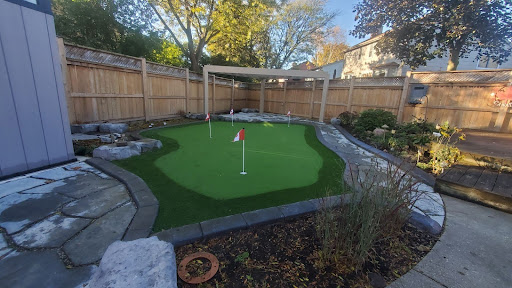If you want to incorporate a lawn into your outdoor space or are wondering how to make the most out of a grassy area on your property, you essentially have two options: natural grass or artificial grass. It is common for homeowners to wonder,”Which is better: synthetic or natural grass?” The answer to that question depends on several factors, including upfront and ongoing costs, the amount of care and maintenance required, sustainability, and personal aesthetic preferences.
While both options are suitable for landscaping purposes, synthetic grass (also often referred to as artificial grass, artificial turf, and synthetic turf) does everything natural grass does, as well as a lot of things natural grass doesn’t. Below, we will compare and contrast artificial grass vs. natural grass and explore how to make the best decision for your family and your property.
The Total Cost of Ownership
In terms of natural grass, installation can involve planting and growing grass from seed or more commonly, laying sod. Beyond that, there are ongoing maintenance responsibilities and expenses to keep your lawn looking lush and healthy, including supplies and equipment such as a lawn mower, edging tool, watering systems, as well as necessary materials to weed, feed, and re-seed your lawn.
While the initial cost to install artificial turf is significantly more than a seeded or sod lawn, maintenance expenses are minimal, if there are any at all. By saving money on maintenance, synthetic grass essentially pays for itself in a relatively small window of time. An artificial turf lawn far outlasts the repayment period, and the savings will continue throughout the life of the lawn.
Care & Maintenance Requirements
One of the most significant differences between synthetic and natural grass is the level of care and maintenance that is required. Maintaining a natural grass lawn means several hours of labour every week to keep it looking its best. Even taking one week off will mean that your lawn will quickly advertise your lack of care and attention.
Artificial grass, on the other hand, only requires minimal care and maintenance. In most cases, rinsing the lawn somewhat regularly to remove dust and potential odors from pet waste is sufficient. Some homeowners choose to brush or rake the synthetic grass blades to keep them vertical and looking fluffy, even in those footpaths and high-traffic areas. Picking up, raking, or blowing away any fallen leaves or other organic matter that lands on the lawn is about all that is necessary to keep your synthetic grass looking perfect and lush year in and year out.
Water Usage & Sustainability
Nobody wants an expensive water bill each month because of high usage. The bad news when it comes to natural grass is that there is no way around it. Depending on which variety of grass you have (and how hardy it is), an 800-square-foot lawn needs approximately 150,000 gallons of water per year.
An artificial grass lawn that is double that size does not require any water at all. The only water needed for synthetic grass is when pets are using the area as a potty zone, and the area needs to be rinsed occasionally. This means saving you money each month on your water bill but also reducing your environmental impact, which is at the forefront of water conservation.
Aesthetics & Feel
The modern varieties of artificial turf that are available today are so realistic in their appearance and feel that it can be difficult to distinguish them from natural grass. However, one significant difference when it comes to aesthetics is that fake grass always looks perfect and uniform in colour, height, texture, and lushness.
Natural grass simply doesn’t have the same uniform appearance, as there can be variations in natural grass lawns, often appearing mottled instead of vibrant green, and in some cases can even appear yellow or dead in spots. And because natural grass is always growing, the only way to maintain uniform height is to mow constantly.
The Bottom Line
Natural and artificial grass are both strong options for a residential or commercial lawn. When deciding on what type of grass to use, it is important to weigh the pros and cons of synthetic turf. Ask yourself such questions as: How much time and money do I want to invest in my lawn, over time? How will the lawn be used? Will it be a space for kids and/or pets? How long do I plan to keep my home?
If you are still unsure about which option is best for you, or you would like to receive a quote, contact us at Mountview Services today!

